We recommend reading our article on choosing the best oil for tempura before this. These articles are part of our tempura series.
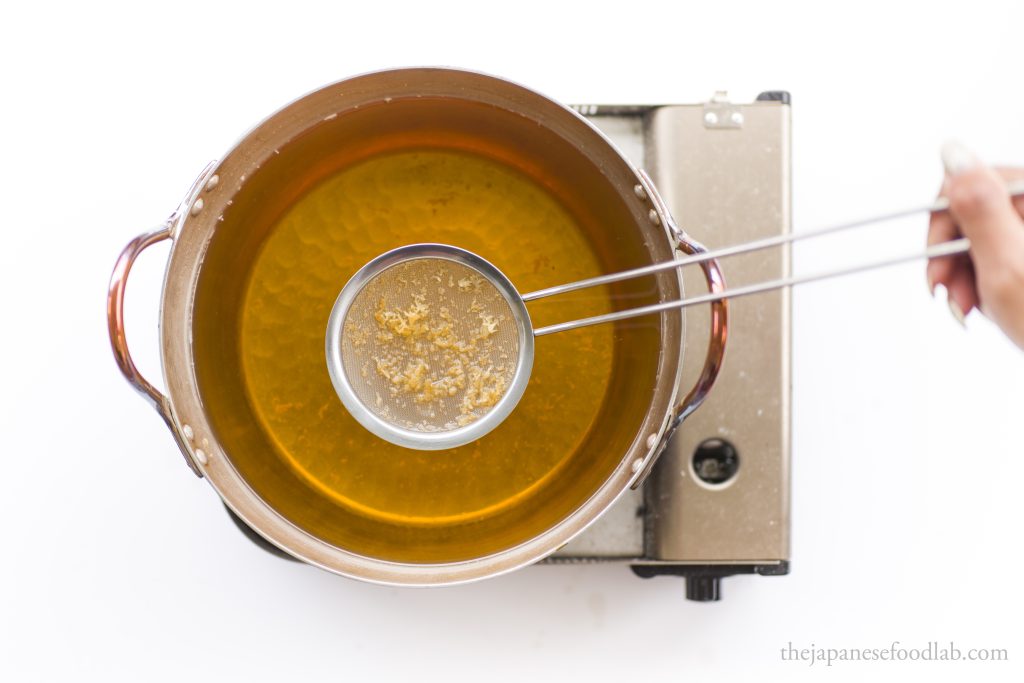
Cultivating your tempura oil
To the casual observer, there exists an air of mystique and exclusivity around specialty Japanese counter seat restaurants. It’s as though their techniques and methods are shrouded in mystery, and only revealed to those who spend years apprenticing under them. This is of course not true, as any long time patron of these establishments can tell you, the secret to what they do is simply sourcing good ingredients and paying attention to detail.
Of course this means that there exist certain narratives, often transmitted through word of mouth, that inaccurately depict these chefs. For example, that sushi chefs serve only the freshest fish, or that they spend every waking moment thinking about how to make better sushi. In the world of tempura, there’s this notion that great tempura can only be made from the freshest oil, which brings to mind the image of a tempura chef throwing out yesterday’s used oil just as today’s guests walk in.
As with most things, the truth is usually a little more nuanced and fresh frying oil does not simply equate to superior tempura. In this article, we attempt to work our way through the entire lifespan of frying oil, which will then lead us to greater insight about how to approach deep frying. Along the way, we’ll try and debunk or verify traditional beliefs held in the tempura community.
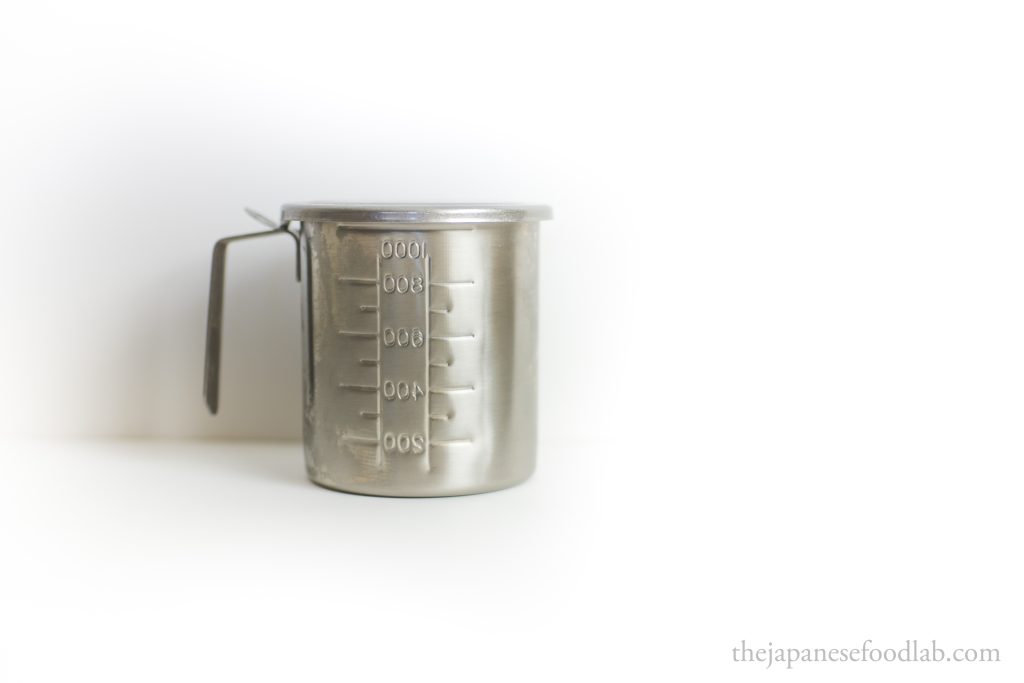
How we approached the subject of deep frying
When it comes to sources of information on deep frying, the most comprehensive books are undeniably Nathan Myhrvold’s modernist cuisine series. Whilst extremely informative, his writing is designed around western deep fried foods like southern fried chicken and fish and chips, which have a different set of defining characteristics compared to tempura. Therefore we wished to write an article which viewed the combined art and science of deep frying through the lens of Japanese cuisine.
Nonetheless, it is still his set of books that perfectly set the perspective through which we should approach deep frying. As he states: ‘chefs neglect to consider that food isn’t the only thing cooking during deep frying, the oil is too!’ As the deep frying oil is heated and cooled again cycle after cycle of frying, it undergoes its own set of chemical changes which impact your final tempura.
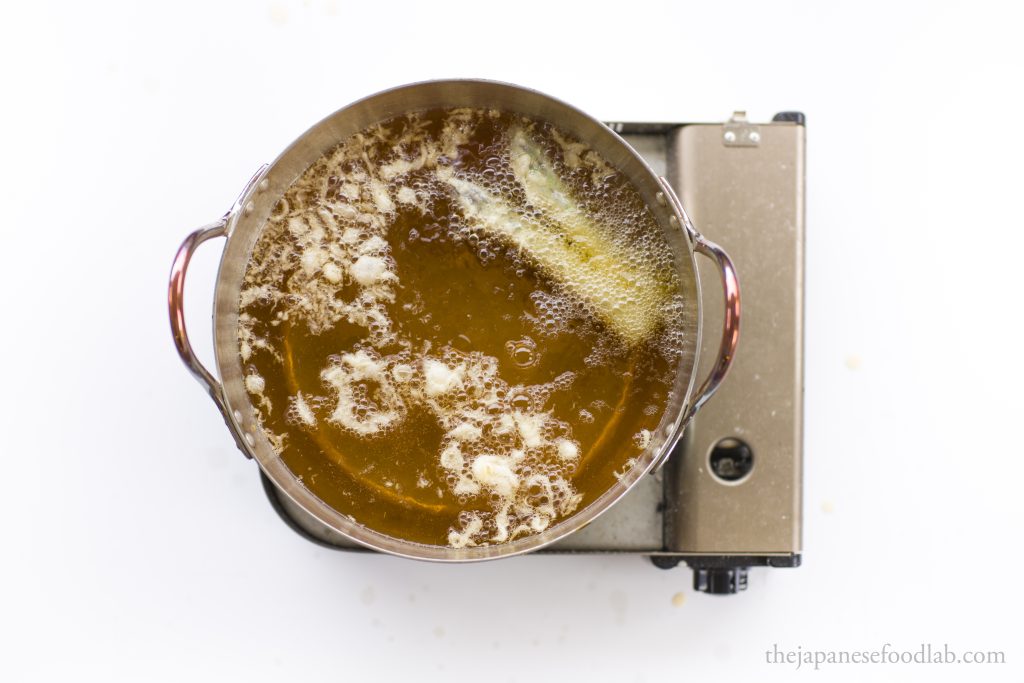
What happens when you deep fry using fresh oil?
The introduction
When you deep fry a piece of food, the bubbling of the food in the oil is actually the water from the food boiling. As the entire piece of food is submerged in oil, the steam from the water boiling has nowhere to escape other than to leave the food through the batter in streams of bubbles. It is this stream of bubbles that provide outward moving propulsion, thus preventing the oil from penetrating the food and making it oily. In fact, the key insight here is that because water has a maximum temperature of 100°C, the steam trapped by the batter is actually cooking the food inside whilst the batter on the outside is being fried.
Contrary to what most people believe, deep frying with the very freshest oil is not ideal. All plant based oils are hydrophobic, meaning that they do not mix well with water. When you deep fry with fresh oil, the steam bubbles from the tempura push away the hot oil, preventing the oil from coming in contact with the tempura for a large part of the cooking duration. Because of this, the resulting tempura not only takes longer to cook, but also does not have the same caramelized and savory taste you’d associate with a crispy golden crust.
It is here however, where the perceptions on good food differ. In the English speaking world, the sign of good fried food is a golden-brown crust and crispy exterior. Food fried only to a pale exterior is undercooked, usually a sign of too little time spent in the oil or too low an oil temperature.
In Japan however, fresh oil is seen as an opportunity to fry ingredients that have a more delicate flavor such as eggplant, asparagus or butterbur. As the resulting tempura has a much lighter taste due to the lack of caramelisation, it is seen as an opportunity to showcase the taste and aroma of ingredients that would be easily overpowered otherwise. In this case, the odorless and tasteless nature of fresh oil can actually be used to an advantage. In fact, snowy white tempura is actually seen as the pinnacle of tempura making around the Kansai region of Japan.
Tempura specialty establishments also employ an interesting technique to break in new oil. If one were to pay attention to the sequence in which courses are served, you’d notice that tempura is actually not served immediately. Instead, the first item usually served are the shell-less prawn heads lightly simmered in the oil without any batter. By using the frying oil to cook prawn heads before starting the tempura, the chefs are essentially priming the oil to produce tempura.
There is a saying among tempura chefs that fresh oil causes the batter to harden quickly. From the various tests we have done, we haven’t been able to find any evidence to support the claim. The closest we could get was the possibility that because tempura cooked with fresh oil absorbs less oil, the textural perception would be crunchier and harder as there was not as much oil to provide lubrication and cushion the mouthfeel.
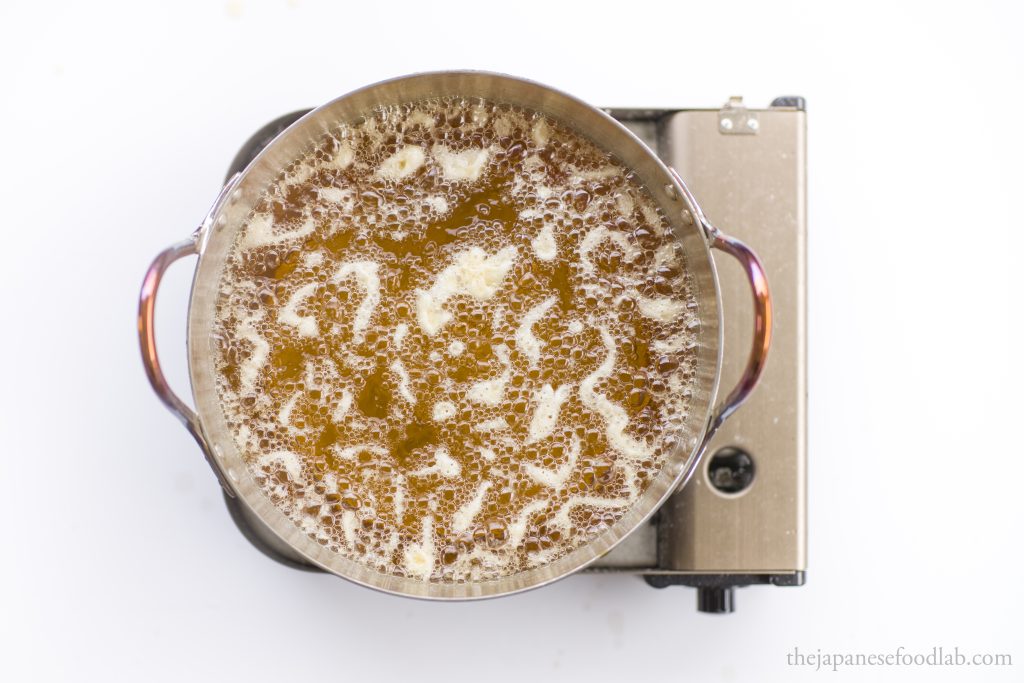
What happens to the oil as deep frying continues?
The verse
As the oil is used more and more, it begins to undergo a process known as hydrolysis. This is where the molecules of oil split, before recombining to form other products. The main product that is of interest to us are emulsifiers. Emulsifiers are chemicals that allow water and oil to mix. Many chefs are familiar with emulsifiers such as soy lecithin, which is used to make culinary foams, or to prevent sauces such as hollandaise from splitting. Most emulsifiers work by having both hydrophilic and lipophilic properties. The hydrophilic part of an emulsifier is what attracts water whilst the lipophilic part is what attracts oil, thus allowing the two to mix without separating.
The increase in the amount of emulsifier in the oil allows the hot oil to mix with the steam erupting from the batter, allowing the oil to remain in contact with the tempura. This means that during the cooking duration, a piece of tempura will spend a long proportion of time in contact with the oil, allowing it to develop a deep golden crust and its associated flavors.
Simultaneously, the process of heating oil over and over again to high temperatures produces a myriad of compounds in the oil with different flavors. Some of these compounds give deep fried food such as tempura their characteristic rich and savory taste. However, other compounds produced at the same time can taste acrid and bitter, giving the oil a stale musty and metallic taste that we associate old deep frying oil with. The proportion of wanted vs unwanted chemicals in the oil varies as the oil is used over and over again.
When is deep frying oil at its prime?
The chorus
As we begin to ‘break in’ our frying oil by heating it and using it, it changes from a neutral odorless oil to one that is rich in aromatic compounds. At this point, the oil is said to be at its peak, as tempura made in this oil absorbs some of the oil, imparting the savory taste and melt-in-your mouth characteristic of well made tempura. This is also possible because enough hydrolysis has occurred to produce enough emulsifiers that allow the tempura to have more contact with the frying oil during the cooking duration, exposing it to higher temperature and developing a more golden hue compared to the white tempura that is made from fresh oil.
In Japan, tempura chefs tend to talk about how the oil slowly absorbs umami from the food previously fried in the oil, so during a multicourse meal, the taste of the tempura progressively gets better and better as umami from the season’s best ingredients are transferred into the oil. Unfortunately, this is simply a myth as the increased savory imparted by the frying oil over time is simply the chemical breakdown of the oil as it’s heated over and over again.
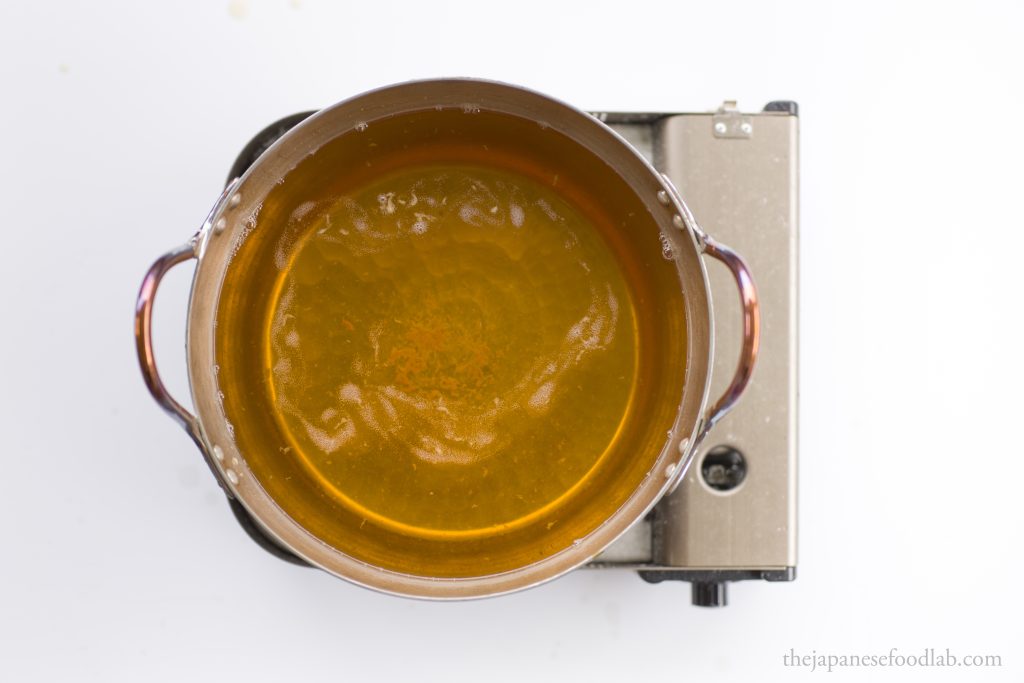
When has frying oil reached the end of its lifespan?
The outro
Unfortunately, the cycle of using the oil over and over again starts to take its toll on the quality of the oil. As the amount of emulsifiers produced increases, the oil begins to be able to mix with more and more water. This gives rise to foam that floats atop oil, indicating that is past its prime. The oil also undergoes polymerisation where free fatty acids bind together to form larger molecules that create a thicker and sticker residue that can give tempura fried in this oil an overly greasy and oily mouthfeel.
At the same time, the proportion of unappetising compounds has built up so much that its taste and smell easily masks any desired ones previously imparted by the oil. This occurs as the oil oxidises as it reacts with oxygen in the air, leading to the formation of free radicals and peroxides, which can impart off-flavors and odors. Most experienced people in the kitchen would recognise this as oil that is ‘spent’, giving food the taste of old oil that some people would describe as stale, fishy or even sour.
In all traditional specialist tempura restaurants, the course of the meal is timed perfectly for the end to coincide just as the oil begins to go past its prime. For longer course meals usually served for dinner, chefs usually opt to change and refresh their frying oil midway through the meal, sometimes up to even 3 or 4 times over a span of 3 hours. This means that customers never have to encounter the tastes of old oil. However, the same cannot be said for lower end restaurants tempura or tendon restaurants where constantly using new oil every service is not financially viable. In these cases, it’s not uncommon for restaurants to continue to use the oil until its last legs to ensure they get every cent’s worth, before finally disposing of the oil and starting afresh.
From our testing, we’ve noticed that tempura fried using older oil has a more brittle crust with much smaller sheets of flakes attached. While we don’t have an explanation for this occurrence, it definitely causes a difference in mouthfeel as the crust is noticeably thinner. Miniscule bits of burnt tempura bits also begin to build up at the bottom of the pot. These bits are unique in that they too small to be caught in the finest sieve or straining, making them impossible to remove outside decanting the oil. This ‘burnt dust’ is agitated during frying and coats the pieces of tempura, giving it a slightly acrid after taste.
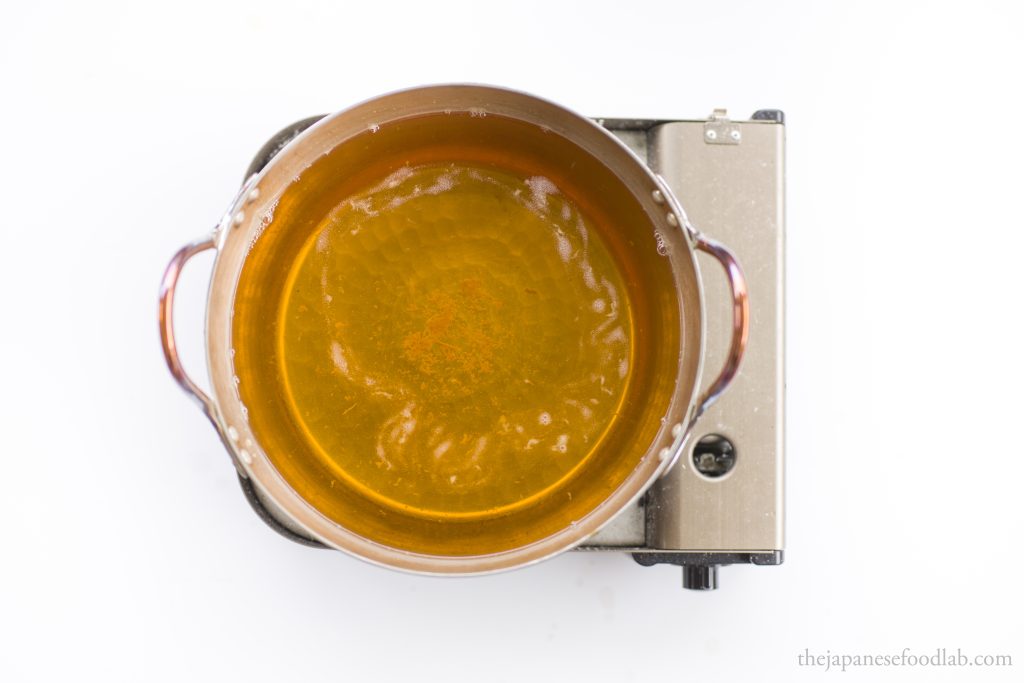
What are the implications for frying great tempura?
Ultimately, the information provided above allows for us to make gentle tweaks to our tempura technique. As we practice overtime, paying attention to the small details and frying with a little more deliberation, that in essence, is what makes the difference between good and great tempura.
When using fresh oil, effort should be made to fry ingredients with a light and delicate taste. As the oil slowly breaks in after the first few pieces, a transition can then be made to ingredients with a more robust flavor. Ingredients with a high water content such as oysters should be fried towards the end as speed up the deterioration of the oil.
There are also certain practices that can be adopted to extend the lifespan of the oil. For example, oil used for one session of deep frying can be diluted or topped up with fresh oil. This not only has the benefit of extending the lifespan of the oil, but also allows you to fry your next batch of tempura without the limitations of fresh oil.
Furthermore, care should be taken to remove the excess pieces of tempura batter leftover in the oil after the food is removed. The emphasis is on not only removing the large pieces that float, but particularly the smaller pieces that sink to the bottom of the pot. As tempura is not usually fried in a commercial deep fryer that has side heating elements, but in a simple pot of oil heated over a flame, these small pieces of tempura have a tendency to break apart and burn at the bottom of the pot. These then attach themselves to freshly fried pieces of tempura, giving them a slightly bitter after taste and oily texture.
A good rule of thumb is to change your oil regularly. If you’re planning to reuse the old oil, it’s highly recommended that you filter the oil first, before storing it in a covered and opaque or dark container. This is to slow down any further deterioration of the oil through oxidation or from exposure to light.
Nathan Myhrvold actually recommends a trick to break in new oil quickly by adding a small amount of old oil to act as a catalyst in the production of desirable aromatic compounds. Whilst this trick definitely works, we have found it to be unnecessary in the context of tempura as there already exists a niche for ingredients that showcase their seasonality when fried in fresh oil.
Lastly, bear in mind that the state of your tempura oil is not clearly defined, but lies on a spectrum from fresh to oil. This means that your pot of frying oil is constantly evolving. In this case, the best way to adapt to slight changes in oil characteristics is to practice as much as possible to develop an intuition.